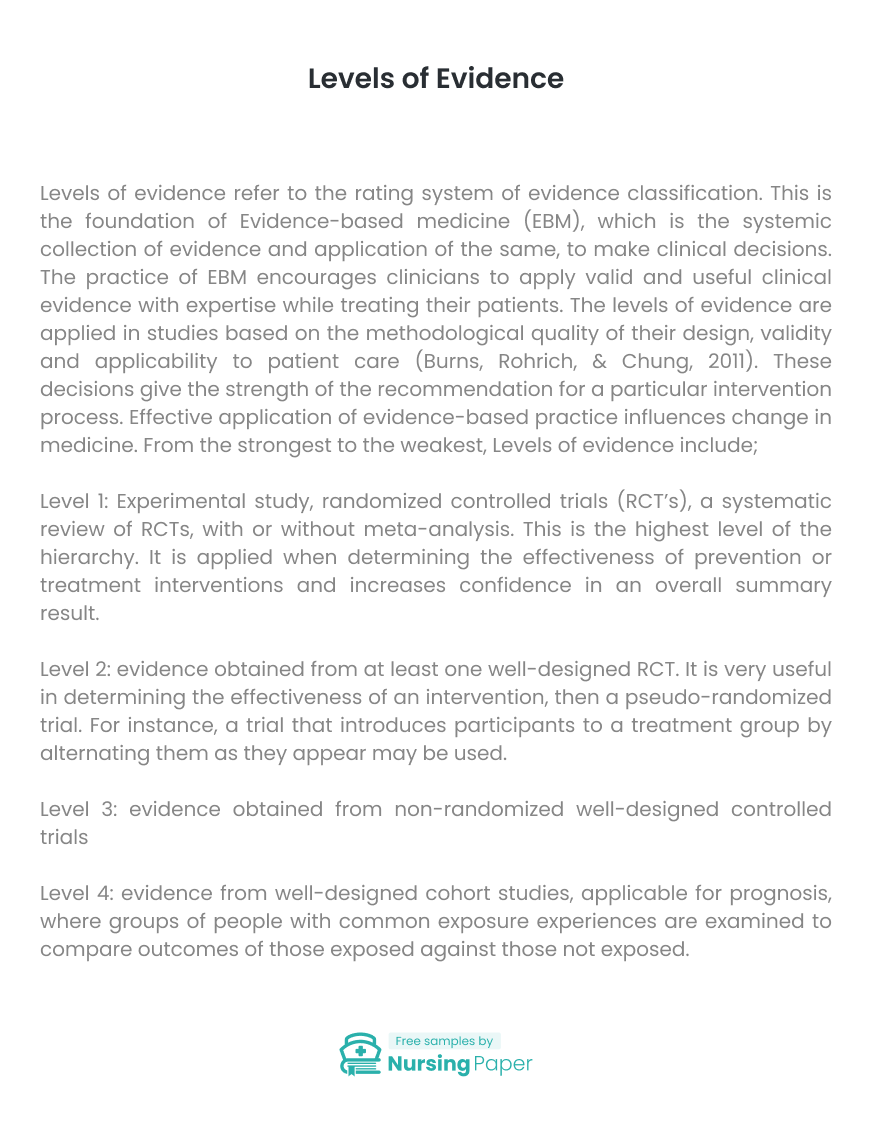
Introduction
Levels of evidence refer to the rating system of evidence classification. This is the foundation of Evidence-based medicine (EBM), which is the systemic collection of evidence and application of the same, to make clinical decisions. The practice of EBM encourages clinicians to apply valid and useful clinical evidence with expertise while treating their patients. The levels of evidence are applied in studies based on the methodological quality of their design, validity and applicability to patient care (Burns, Rohrich, & Chung, 2011). These decisions give the strength of the recommendation for a particular intervention process. Effective application of evidence-based practice influences change in medicine. From the strongest to the weakest, Levels of evidence include.
Levels
Level 1: Experimental study, randomized controlled trials (RCT’s), a systematic review of RCTs, with or without meta-analysis. This is the highest level of the hierarchy. It is applied when determining the effectiveness of prevention or treatment interventions and increases confidence in an overall summary result.


Level 2: evidence obtained from at least one well-designed RCT. It is very useful in determining the effectiveness of an intervention, then a pseudo-randomized trial. For instance, a trial that introduces participants to a treatment group by alternating them as they appear may be used.
Level 3: evidence obtained from non-randomized well-designed controlled trials.
Level 4: evidence from well-designed cohort studies, applicable for prognosis, where groups of people with common exposure experiences are examined to compare outcomes of those exposed against those not exposed.

Level 5: evidence from systematic reviews of descriptive and qualitative studies (meta-synthesis). It uses the interpretative technique to develop small study findings to clinical practice.
Level 6: evidence from a single descriptive study on systems, behaviors, culture and group dynamics, using statistical methods to establish numerical relationships of causes and effects.
Level 7: Evidence from the opinion of authorities and reports of expert committees. Considered the lowest level of evidence, but it is very useful when research evidence (both qualitative and quantitative) is unavailable.



Conclusion
While searching for evidence, the highest level of evidence should be applied and information that hasn’t been critically appraised is deemed unfiltered (Melnyk, & Fineout-Overholt, 2011). We should use the lower levels of evidence whenever our resources at the top are limited. For instance, level 1 is considered the most effective because it reduces the chances of bias since RCTs have such ability within them, unlike level 7, which is the weakest design. Clinicians should consider which research design is appropriate for each research question. Therefore, a research design is not weak on its own, but it all depends on the research issue and the availability of resources. This means that the order of the hierarchy can always be reversed depending on the clinical situation. However, a healthy level of judgment should be used to appraise evidence and apply it in routine clinical practice.
1. Burns, P. B., Rohrich, R. J., & Chung, K. C. (2011). The levels of evidence and their role in evidence-based medicine. Plastic and reconstructive surgery, 128(1), 305.
2. Grol, R., & Wensing, M. (2004). What drives change? Barriers to and incentives for achieving evidence-based practice. Medical Journal of Australia, 180(6 Suppl), S57.
3. Melnyk, B. M., & Fineout-Overholt, E. (Eds.). (2011). Evidence-based practice in nursing & healthcare: A guide to best practice (2nd Ed.). Lippincott Williams & Wilkins, Pp. 10.
4. Peterson, M. H., Barnason, S., Donnelly, B., Hill, K., Miley, H., Riggs, L., & Whiteman, K. (2014). Choosing the best evidence to guide clinical practice: Application of AACN levels of evidence. Critical care nurse, 34(2), 58-68.



The download will start shortly.

The download will start shortly.
 Subject:
Nursing
Subject:
Nursing  Number of pages: 5
Number of pages: 5  Subject:
Nursing
Subject:
Nursing  Number of pages: 4
Number of pages: 4  Subject:
Nursing
Subject:
Nursing  Number of pages: 3
Number of pages: 3  Subject:
Health and Social Care
Subject:
Health and Social Care  Number of pages: 5
Number of pages: 5  Subject:
Nursing
Subject:
Nursing  Number of pages: 2
Number of pages: 2  Subject:
Health and Social Care
Subject:
Health and Social Care  Number of pages: 2
Number of pages: 2  Subject:
Health and Social Care
Subject:
Health and Social Care  Number of pages: 5
Number of pages: 5  Subject:
Nursing
Subject:
Nursing  Number of pages: 6
Number of pages: 6  Subject:
Nursing
Subject:
Nursing  Number of pages: 5
Number of pages: 5  Subject:
Health and Social Care
Subject:
Health and Social Care  Number of pages: 7
Number of pages: 7  Subject:
Medicine
Subject:
Medicine  Number of pages: 2
Number of pages: 2  Subject:
Medicine
Subject:
Medicine  Number of pages: 17
Number of pages: 17  Subject:
Medicine
Subject:
Medicine  Number of pages: 4
Number of pages: 4  Subject:
Nursing
Subject:
Nursing  Number of pages: 4
Number of pages: 4  Subject:
Nursing
Subject:
Nursing  Number of pages: 8
Number of pages: 8 
